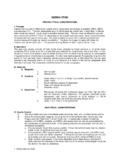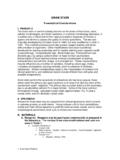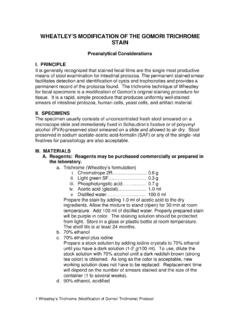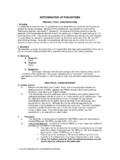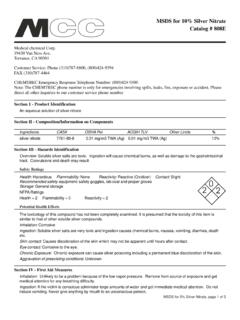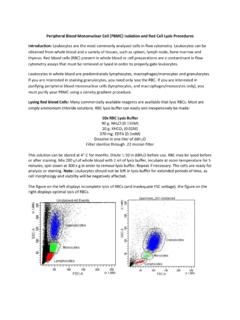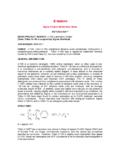Transcription of WRIGHT’S ONE STEP ST AIN - Med-Chem
1 1 Garcia ( wright s One step Stain) wright S ONE step STAIN PREANALYTICAL CONSIDERATIONS I. Principle wright sDip STAT Stain is used to differentiate nuclear and/or cytoplasmic morphology of platelets, RBCs, WBCs, and parasites (1,2). The traditional wright s stain, an alcoholic solution of methylene blue and eosin Y, dates from the early 1890 s. There have been many modifications, most of which involve oxidative demethylation of the methylene blue to improve polychroming. Modern day samples of the dye usually contain mixtures of methylene blue, azure A, and thionin (the mixture is often called polychromed methylene blue ) compounded with eosin Y.
2 Medical Chemical s wright s Dip Stat contains the azures and the eosin Y in separate solutions, which improves staining control and reproducibility, as well as speed. The total staining time is about thirty seconds or less. The traditional stain is diluted 1:1 with Giordano buffer before use. wright s One step stain contains the buffer already dissolved in the stain. The slides are stained in the undiluted stain and differentiated by decolorizing in purified water. II. Specimen The specimen usually consists of fresh whole blood collected by finger puncture or of whole blood containing EDTA ( g/10 ml of blood) that was collected by venipuncture and is less than 1 h old.
3 Heparin (2 mg/10 ml of blood) or sodium citrate ( g/10 ml of blood) may be used as an anticoagulant if trypanosomes or microfilariae are suspected. If slides have been prepared, the specimen may be a thin blood film that has been fixed in absolute methanol and allowed to dry, a thick blood film that has been allowed to dry thoroughly and is not fixed, or a combination of a fixed thin film and an adequately dried thick film (not fixed). The combination thick/thin blood film is also acceptable.
4 III. Materials A. Reagents 1. wright s One step stain 2. Deionized Water B. Supplies 1. Glass slides (1 by 3 in., or larger if you prefer), alcohol washed 2. Glass marker 3. Blood collection supplies (if applicable) 4. Paper with newsprint-size print 5. Applicator sticks C. Equipment 1. Microscope, binocular with mechanical stage; low (10x), high dry (40x), and oil immersion (100x) objectives; 10x oculars; calibrated ocular micrometer; light source equivalent to 20-W halogen or 100-W tungsten bulb; blue and while ground-glass diffuser filters 2.
5 Timer, 1 h or more in 1-min increments ANALYTICAL CONSIDERATIONS IV. Quality Control A. The solutions and deionized water should be clear, with no visible contamination. B. Prepare and stain films from normal blood, and microscopically evaluate the staining reactions of the RBCs, platelets, and WBCs; this assessment can also be accomplished by the examination of your patient slide. If the staining reactions are acceptable, then the QC is considered acceptable. a. Microscopically, RBCs appear light tan, reddish or buff, and WBCs have bright blue nuclei and lighter cytoplasm.
6 Eosinophilic granules are bright red, and neutrophilic granules are pink or light purple. 2 Garcia ( wright s One step Stain) b. Slight variation may appear in the colors described above depending on the batch of stain used and the character of the blood itself, but if the various morphological structures are distinct, the stain is satisfactory. c. If malaria parasites are present, the cytoplasm stains pale blue and the nuclear material stains red. Sch ffner s dots and other RBC inclusions usually do not stain or stain very pale with wright s stain.
7 While the sheath of microfilariae may not always stain, the nuclei within the microfilariae always stain pale to dark blue. C. Although there is not universal agreement, the microscope should probably be recalibrated once each year. This recommendation should be considered with heavy use or if the microscope has been bumped or moved multiple times. If the microscope does not receive heavy use, then recalibration is not required on a yearly basis. D. Record all QC results. V. Procedure* A. Wear gloves when performing this procedure.
8 B. Thin blood films (only) Dip Method 1. Dip air dried blood film in undiluted stain for 15 to 30 seconds (double the staining time for bone marrow smears). 2. Decolorize the stained smears by immersion in distilled or deionized water and air dry 3. Let air dry in a vertical position. Thin blood films (only) Rack Method 1. Lay air dried slides on staining rack and flood with stain; stain for 10 to 15 seconds (double the staining time for bone marrow smears). 2. Add an equal volume of deionized/distilled water and stain for 10 seconds.
9 3. Rinse the slide by dipping in deionized/distilled water for 30 seconds. The slide may also be rinsed by swishing or washing with deionized/distilled water. C. Thick blood films (only) 1. Allow film to air dry thoroughly for several hours or overnight. Do not dry films in an incubator or by heat, because this will fix the blood and interfere with the lysing of the RBCs. Note: If a rapid diagnosis of malaria is needed, thick films can be made slightly thinner than usual, allowed to dry for 1 h, and then stained.
10 2. Lake the thick film by immersing in distilled or deionized water for 10 min. 3. Allow the film to air dry thoroughly. 4. Fix air-dried film in absolute methanol for 30 seconds in a Coplin jar containing absolute methanol. 5. Allow the film to air dry. 6. Dip air dried blood film in undiluted stain for 15 to 30 seconds (double the staining time for bone marrow smears). 7. Decolorize the stained smears by immersion in distilled or deionized water and air dry 8. Let air dry in a vertical position. D. Thin and thick blood films on the same slide 1.
